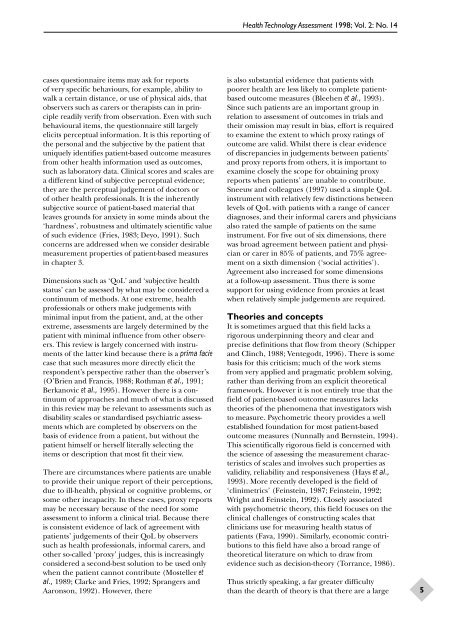Evaluating Patient-Based Outcome Measures - NIHR Health ...
Evaluating Patient-Based Outcome Measures - NIHR Health ...
Evaluating Patient-Based Outcome Measures - NIHR Health ...
Create successful ePaper yourself
Turn your PDF publications into a flip-book with our unique Google optimized e-Paper software.
cases questionnaire items may ask for reports<br />
of very specific behaviours, for example, ability to<br />
walk a certain distance, or use of physical aids, that<br />
observers such as carers or therapists can in principle<br />
readily verify from observation. Even with such<br />
behavioural items, the questionnaire still largely<br />
elicits perceptual information. It is this reporting of<br />
the personal and the subjective by the patient that<br />
uniquely identifies patient-based outcome measures<br />
from other health information used as outcomes,<br />
such as laboratory data. Clinical scores and scales are<br />
a different kind of subjective perceptual evidence;<br />
they are the perceptual judgement of doctors or<br />
of other health professionals. It is the inherently<br />
subjective source of patient-based material that<br />
leaves grounds for anxiety in some minds about the<br />
‘hardness’, robustness and ultimately scientific value<br />
of such evidence (Fries, 1983; Deyo, 1991). Such<br />
concerns are addressed when we consider desirable<br />
measurement properties of patient-based measures<br />
in chapter 3.<br />
Dimensions such as ‘QoL’ and ‘subjective health<br />
status’ can be assessed by what may be considered a<br />
continuum of methods. At one extreme, health<br />
professionals or others make judgements with<br />
minimal input from the patient, and, at the other<br />
extreme, assessments are largely determined by the<br />
patient with minimal influence from other observers.<br />
This review is largely concerned with instruments<br />
of the latter kind because there is a prima facie<br />
case that such measures more directly elicit the<br />
respondent’s perspective rather than the observer’s<br />
(O’Brien and Francis, 1988; Rothman et al., 1991;<br />
Berkanovic et al., 1995). However there is a continuum<br />
of approaches and much of what is discussed<br />
in this review may be relevant to assessments such as<br />
disability scales or standardised psychiatric assessments<br />
which are completed by observers on the<br />
basis of evidence from a patient, but without the<br />
patient himself or herself literally selecting the<br />
items or description that most fit their view.<br />
There are circumstances where patients are unable<br />
to provide their unique report of their perceptions,<br />
due to ill-health, physical or cognitive problems, or<br />
some other incapacity. In these cases, proxy reports<br />
may be necessary because of the need for some<br />
assessment to inform a clinical trial. Because there<br />
is consistent evidence of lack of agreement with<br />
patients’ judgements of their QoL by observers<br />
such as health professionals, informal carers, and<br />
other so-called ‘proxy’ judges, this is increasingly<br />
considered a second-best solution to be used only<br />
when the patient cannot contribute (Mosteller et<br />
al., 1989; Clarke and Fries, 1992; Sprangers and<br />
Aaronson, 1992). However, there<br />
<strong>Health</strong> Technology Assessment 1998; Vol. 2: No. 14<br />
is also substantial evidence that patients with<br />
poorer health are less likely to complete patientbased<br />
outcome measures (Bleehen et al., 1993).<br />
Since such patients are an important group in<br />
relation to assessment of outcomes in trials and<br />
their omission may result in bias, effort is required<br />
to examine the extent to which proxy ratings of<br />
outcome are valid. Whilst there is clear evidence<br />
of discrepancies in judgements between patients’<br />
and proxy reports from others, it is important to<br />
examine closely the scope for obtaining proxy<br />
reports when patients’ are unable to contribute.<br />
Sneeuw and colleagues (1997) used a simple QoL<br />
instrument with relatively few distinctions between<br />
levels of QoL with patients with a range of cancer<br />
diagnoses, and their informal carers and physicians<br />
also rated the sample of patients on the same<br />
instrument. For five out of six dimensions, there<br />
was broad agreement between patient and physician<br />
or carer in 85% of patients, and 75% agreement<br />
on a sixth dimension (‘social activities’).<br />
Agreement also increased for some dimensions<br />
at a follow-up assessment. Thus there is some<br />
support for using evidence from proxies at least<br />
when relatively simple judgements are required.<br />
Theories and concepts<br />
It is sometimes argued that this field lacks a<br />
rigorous underpinning theory and clear and<br />
precise definitions that flow from theory (Schipper<br />
and Clinch, 1988; Ventegodt, 1996). There is some<br />
basis for this criticism; much of the work stems<br />
from very applied and pragmatic problem solving,<br />
rather than deriving from an explicit theoretical<br />
framework. However it is not entirely true that the<br />
field of patient-based outcome measures lacks<br />
theories of the phenomena that investigators wish<br />
to measure. Psychometric theory provides a well<br />
established foundation for most patient-based<br />
outcome measures (Nunnally and Bernstein, 1994).<br />
This scientifically rigorous field is concerned with<br />
the science of assessing the measurement characteristics<br />
of scales and involves such properties as<br />
validity, reliability and responsiveness (Hays et al.,<br />
1993). More recently developed is the field of<br />
‘clinimetrics’ (Feinstein, 1987; Feinstein, 1992;<br />
Wright and Feinstein, 1992). Closely associated<br />
with psychometric theory, this field focuses on the<br />
clinical challenges of constructing scales that<br />
clinicians use for measuring health status of<br />
patients (Fava, 1990). Similarly, economic contributions<br />
to this field have also a broad range of<br />
theoretical literature on which to draw from<br />
evidence such as decision-theory (Torrance, 1986).<br />
Thus strictly speaking, a far greater difficulty<br />
than the dearth of theory is that there are a large<br />
5
















